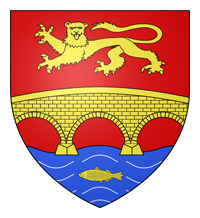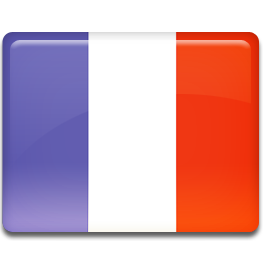 |
Welcome to Pont-d'Ouilly |


2014 News - D-day, the 70th


To commemorate the 70th anniversary of D-day, the Pays de Falaise exhibits on the theme of Occupation to Liberation.
In Pont-d'Ouilly, large posters are placed on the front of the town hall and old Market, a set of 6 panels is arranged on the banks of the Orne along the Promenade du Docteur Alain Thomas, and 4 other posters are also available at the entrance of the old Market.
1 - Death for France...


The gallant last stand of June 17, 1940
Engaged in the Netherlands and Belgium in May 1940, the 224th Infantry Regiment was evacuated from Dunkirk to England and then offloaded in Cherbourg. One of its companies reached Pont-d’Ouilly on June 17th; both officers commanding it were killed while defending the bridge. This was how Caen-born Lieutenant Jean Formey de Saint-Louvent, and his second-in-command, Sub-Lieutenant Félix Rouy, lost their lives.
As another survivor of the Dunkirk evacuation which had arrived from Alsace, the 1st GR 32 squadron, a rearguard element of the 43rd Infantry Division, took position in Pont-d’Ouilly on June 17th at about 10 a.m. The lieutenant in charge of the machine gun platoon assessed how tricky the situation was. The crowd of refugees, the embroilment of civilian vehicles made any effective manoeuvre impossible to conduct. In spite of all this, the order was to hold the bridge, which for lack of explosives could not be destroyed, and so machine guns and a mortar were positioned on both sides of the river. Some German motorcyclists who had concealed themselves within the stream of refugees opened fire. The platoon retaliated and brought the enemy column to a halt. The fighting went on until 5 p.m. Having run out of ammunition, and having not received any news from his superior officers, Lieutenant Lecomte decided to pull back near Saint-Marc-d’Ouilly and retreat.
Yet this was also about the brave conduct a battery of 75 men showed, having been left without any officers to lead them. Placed under the command of Battery Sergent-Major Duclos, it held up Field Marshal Rommel’s 7th Panzer Division vanguards at the Pautiche junction for several hours at the cost of heavy losses.
2 - May 22,1941 the Wehrmacht on manoeuvres in Pont-d'Ouilly


Here is an unusual photographic report one of the soldiers of the occupation troops drew up. The theme behind the manoeuvre was undoubtedly the crossing of the Orne River with makeshift rafts, it having been conceived that the bridge would be destroyed. This was the month of May and the river had swollen as a result of spring showers.
After the bridge was destroyed in August 1944, when the time had come for it to be crossed during battles, the modest coastal river was to have quietened down. In the heart of summer, fording it was indeed possible at several points. This was in fact the opportunity British troops seized as they forded the Orne River 15.5 miles downstream from Grimbosq.
3 - Leave at once! There is not a minute to lose!


Built in the shape of an amphitheatre around the banks of the Orne and of the River Noireau, and from the road running from Condé to Falaise, the centre of Pont-d’Ouilly (which was then known as Saint-Marc-d’Ouilly and Ouilly-le-Basset) constituted a major strategic goal. This caused it to be bombed on several occasions in June, July, and mostly in early August 1944.
From the first days following the D-Day Landings, the village centre witnessed a flow of refugees coming in from the district of Caen, then German troops who were retreating southward, and finally the British liberators. Having sustained attacks and counter-attacks, a forced evacuation, pillages and humiliations by the occupying forces that were in dire straits, the much-awaited Liberation was to take a heavy toll on the civilian population. Twenty-two civilian casualties, eleven women and eleven men, were listed.
The freedom that had been regained went hand in hand with pictures which are nowadays well known: liberators being decorated with flowers, white bread, chocolate and British cigarettes being handed out, Resistance fighters. The town doctor Roger Cornu (who was to become mayor), member of the resistance, arrested on March 25, 1944 and deported on July 15th to the Neuengamme concentration camp where he was assigned to the serial number 36696, was being missed by his fellow citizens. Life went on as best as possible amid the ruins. Nearly ten years had elapsed before the Reconstruction got underway.
4 - Planes flew back up to nine times that day...

Before the war, Father Joseph DELACOTTE had made himself the painter and historian of the “Suisse Normande” countryside. His keen eye also succeeded in capturing through a moving account this period of deep suffering yet also of great hope for civilian populations. His words were collected in 1947 by Norman Historian and Writer René Herval in the book “The Battle of Normandy as Told by Eyewitnesses”.

…Pont-d’Ouilly had once again been bombed on August 10th [1944]. Planes flew back up to nine times that day – then and the following days, with the very firm intention of blowing the bridge up. Many bombs fell, as always, on neighbouring houses. Finally, on the 12th, the bridge which had already been mined by the Germans collapsed over the river. The enemy had by then taken flight, headed for Putanges and the upper Orne valley…
On August 15th [1944], it had all ended and the enemy continued its retreat. That same day, the British arrived in Pont-d’Ouilly. At two o’clock in the afternoon, a column of tanks and trucks was driving by the village of Saint-Christophe, having arrived from the heights of Saint-Clair. A most regrettable incident occurred at that point, due, it would appear, to the fact that the British were several hours ahead of schedule. Allied planes flew over them, and having mistaken them for German forces, started to spray them with bullets. Ammunition trucks exploded and several houses burned down. The outstanding patriot Charles Gomont, as well as a neighbour, Mme Olivier, died having fallen victim to this fatal mistake…
5 - Without the Bailey bridge we should not have won the war

Pont d’Ouilly (which literally means the “Bridge of Ouilly”), a stone bridge which has straddled the Orne River since 1851 but whose origins can be traced back to Gallo-Roman times, was assaulted on several occasions in June and July 1944 by the RAF Bomber Command that missed its target. The mines placed by the Germans in early August eventually exploded under British bombings on August 12th, thus destroying both central arches.

The 59th British Infantry Division liberated the village on the 15th, and as from the 19th, the military engineering corps put up a temporary metal Bailey bridge that rested on those parts of the stone bridge which had not been destroyed. And as one might as well combine business with pleasure, the work was named after a young girl who watched the work go on: Jacqueline Sébire. The newly-rebuilt bridge was to be inaugurated in 1948, yet the former dismantled metal footbridge can still be seen in Falaise.
Light prefabricated works designed by engineer Donald Bailey in the early 1940s could be assembled within two hours by a team of forty men. “Without the Bailey Bridge, we should not have won the war. It was the best thing in that line that we ever had”, asserted Field Marshal Montgomery.
6 - With your help France shall be rebuilt

Autumn 1944, while the fighting had grown more distant, the war had not in any way drawn to a close. People strove to clear up what remains there were of houses, reinforce the ruins as best they could and retrieve furniture and items which had been spared by the bombings and pillaging. A few temporary camps were erected along the road to Caen and in the park near the church.
Damage assessment was also conducted: thirty-three houses, the school and the town hall had been destroyed in Ouilly-le-Basset, seven in Saint-Marc. This caused both communes to be declared disaster areas on July 18, 1945 by order of the prefect. It was hoped the reconstruction would be rapid. Things were not so simple. From disputed urban designs to tricky land consolidation, awkward expropriations orders to the village council threatening to resign, hardly any progress was made. Even though the bridge, the agglomeration’s emblem, was open to traffic on April 8, 1948 and inaugurated the following month.

In order to quicken procedures and even out the reconstruction on both sides of the Orne, elected members decided to merge both municipalities. On August 23, 1947, Ouilly-le-Basset and Saint-Marc-d’Ouilly became Pont-d’Ouilly. Marcel Guyon was its first mayor. Yet the actual reconstruction only began in October 1953 with that of the Hôtel du Commerce and the cluster of houses in the centre. It enabled a certain number of interesting buildings to be safeguarded, the embankments to be enhanced, driving through the centre easier and allow for its future expansion.
A - After having been defeated and occupied, France saw that fightings against the enemy was the only way to salvage their existence and greatness

The Saint-Clair maquis
In early 1944, the Saint-Clair maquis brought together – under the authority of a twenty-year-old French officer from Bordeaux, Jean Renaud-Dandicolle – those Resistance groups who were operating in a wide area southeast of Caen. He, whom his companions called “Capitaine Jean”, was a member of the Special Operations Executive, the famous S.O.E. British secret organisation that intervened in occupied territories.
Headcount in the maquis – which assembled among others the groups based in Barbery, Bretteville-sur-Laize, Cesny-Bois-Halbout and Pont-d’Ouilly – amounted to just around a hundred men. Jean-Renaud-Dandicolle proceeded to have Sten submachine guns, explosives and tyre deflation devices dropped by parachute to fit his men out. But the British were also practical-minded: there was chocolate, biscuits and cigarettes.
Intelligence which was to enable, among other things, the V1 Cauvicourt and Breteville-sur-Laize launch ramps to be located and destroyed, parachuted supplies to be received, allied airmen who were shot down to be assisted, and then from June 6th onwards, railway lines to be sabotaged and trains to be attacked. Such were the many actions these Resistance fighters undertook. All Saint-Clair maquis activities ceased on July 8, 1944 after “Captain Jean” and several of his companions were arrested and executed.
B - The worker’s call on a misty morning

Airdropping and acts of sabotage in the “Suisse Normande” countryside
Arming, equipping and organising the resistance movement in Lower Normandy was one of the missions Jean Renaud-Dandicolle was entrusted with by the S.O.E. Poorly armed with shotguns or weapons they had retrieved after the French army had been routed, the shadow fighters lacked efficiency and firepower. The airdropping of weapons occurred several times at the end of 1943, and mostly throughout the first semester of 1944.
An identical pattern was followed each time. An open field would be scouted, one large enough and which was well away from the roads the enemy used, its coordinates would be radioed to England, a team of eight men in charge of marking the site would be set up. Actors would feverishly await the message from the BBC, sometimes for several days. Red or white lamps would flash in the night, visual signals using Morse code, the invaluable containers would be dropped amid the roaring of British bomber engines, and then very quickly before sunrise, the weapons and equipment which had been dropped were hidden in a trustworthy farm.
The most significant armed attack the Saint-Clair resistance fighters conducted was sabotaging the Caen-Flers railway line near Grimbosq Halt on the night of June 5-6, 1944, at the exact same time the Allies were approaching the Normandy coast. The same night that attack took place, a German convoy was also assaulted near the lake in Meslay, and over the following days, the “roads and guerilla warfare” plan was put into effect. Its purpose was to delay the advance of German troops by felling trees and using tyre-deflation devices.
C - The resistance was about actively hoping for a fairer world

The martyrdom of Grosclaude farm
On the night of July 6-7, 1944, Jean Renaud-Dandicolle – known as “Capitaine Jean”, head of the Saint-Clair maquis – spent the night at the farm owned by George and Eugénie Grosclaude, farmers who were members of the Resistance and harboured an arms depot and gave shelter to “maquisards” (Resistance fighters). He brought with him his radio operator, British Lieutenant Maurice Larcher, a Canadian pilot known as Cleary, and a French maquisard called Jean Foucu. They decided to relocate the maquis’ headquarters in the Mayenne department the following day, but spent a final night at the farm as “the Grosclaude had prepared a hearty meal”. In the early hours of July 7th, two German soldiers stationed in the woods nearby showed up at the farm to presumably commandeer it. Confrontation was unavoidable, and both Germans were shot dead yet having had time to sound the alarm. The reprisals were instant: Larcher and Cleary were killed, Foucu and Renaud-Dandicolle ran away but the latter was captured; as for the Grosclaude couple, who were horrifically tortured, their bodies were never found. All trace was also lost of “Capitaine Jean”, who was no doubt executed a few hours after having been arrested.
Recklessness, denunciation or fortuitous circumstances, the various investigations which were conducted after the war never fully got to the bottom of this affair and did not enable the bodies of three of the victims to be found either.
A memorial erected at the site where the tragedy occurred was inaugurated on July 6, 1947.
D - Mon village à l'heure allemande

Stored in the Departmental Archives of Calvados, the council meeting records of Saint-Marc-d’Ouilly (nowadays Pont-d’Ouilly) provide good insight as to what daily life was like in a French village during the Occupation.
Living under a new political regime, the french state
“In the year 1940, on November 10th at 10 a.m. (German time), the council which had been legally convened under the chairmanship of Monsieur Charles Constantin, resolved to purchase three portraits of Head of State Marshal Pétain which were to be affixed in the Town Hall and schools…”
Day-to-day shortages and rationing
“In the year 1941, on January 25th at 3 p.m. (German time), the council set up a Shoe Rationing Commission. It included the Mayor, who was chairman, and Messrs Biot, Delacour and Dupont who were members.”
Supplying the occupying troops with food
“In the year 1941, on October 14th at 3 p.m. (German time), the council, with the potato harvest having appeared to be terribly poor, requested it be granted up to October 20th to work out a fair allocation of the quota which was to be provided. It did, however, already point out that contributing the 48 mandatory tons was out of proportion with what the town could possibly produce.”
As recorded for each council deliberation, legal time became German time. A communiqué issued by the occupation authorities and taken up by the daily Caen papers on June 25, 1940 announced: “The clock moves forward. In order to standardise time, the German military command has ordered that Central European time be adopted in Caen tonight; at midnight, you will therefore have to move your watches and clocks forward by an hour.”


